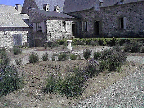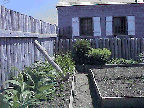
Behind Website Design and Content © by
Eric Krause, Krause House Info-Research Solutions
(© 1996)
All Images ©
Parks Canada Unless Otherwise Designated
Researching
the Fortress of Louisbourg National Historic Site of Canada
Recherche sur la Forteresse-de-Louisbourg Lieu historique national du Canada
Search All Sites/All Menus ~
Cherche Tous les Sites/Tous les Menus
Behind The Scenes Site

Discipline and Beauty: The Orderly Gardens of Louisbourg
Eighteenth century French gardens were among the most sophisticated and artistic ever created, the culmination of an art that had developed over centuries through all the ancient cultures. Their precursors, the gardens of Renaissance Italy, demonstrated a magnificent blend of subtle harmony and perfect proportions. Visitors to Italy greatly admired the way in which gardeners merged architecture, flowers, green vegetation, sculpture, trees and water courses into a unified whole. Adaptations of this style were made by architects over the next two centuries, with the English moving toward a freer expression that incorporated features of the natural environment in the overall design and the Dutch greatly scaling down the large estate design to suit tiny properties. In was the French, however, who achieved the ultimate in garden art, in the construction of gardens at Versailles, commissioned by Louis XIV and designed by Le Notre. These gardens took 50 years to complete and to enhance their use and enjoyment, the King himself wrote a guide for visitors.
The French style was based on four main principles: logic, order, discipline and beauty. The first three elements were displayed by the rigid garden layout while the last was expressed by the arrangement of plants within that layout. Designs were geometrical and symmetrical, with a great deal of attention paid to contrasting shades of green, the heights of plants, and different textures of foilage.
French gardens had definite patterns that called for specific dimensions and precise ways of planting. Squares or rectangles were divided into beds of equal size by systems of wide paths. Raised planting surfaces were bordered by aromatic plants, attractive shrubs, or flowers. The planting surfaces were then sectioned into smaller beds incorporating precise divisions and mirror images. Every garden, whether large or small, adhered to this general plan. The book La Nouvelle Maison Rustique, published in the 1750s in France, outlines very specific rules and dimensions, including the exact width of paths, planting surfaces and beds. These rules were followed in contemporary kitchen gardens, orchards, ornamental gardens, and medicinal gardens.
Eighteenth century French gardening was not only advanced in design but also in technique. They composted organic material, brought in top soil from more fertile areas, used greenhouses and hotbeds, practised crop rotation, and laid sod for lawn areas. Their sophisticated practices, with Versailles as the model, influenced gardening throughout Europe and eventually in the New World.
This complex style of gardening could not be transplanted intact from France to the colonial situation. Various conditions at Louisbourg necessitated modifications to the French notion of the "ideal garden". Cultivation at the fortress town was mainly of the potager or kitchen garden type for several very good reasons. Most lots of land within the town walls were small and did not provide space for more than the versatile potager. Many plants that the colonists were accustomed to growing at home would not survive in Louisbourg's short, damp growing season. The area's thin, acid soil and short summer season were simply not conducive to large-scale agriculture, which made basic survival a vital consideration in determining the type of gardening done.
As Louisbourg was dependent on outside sources (France, Québec, Acadia and New England) for the bulk of its food supplies, any food that could be produced in the town was welcome. In 1744, with the declaration of war between France and Great Britain, enemy privateering and a crop failure in Québec combined to encourage Louisbourg residents to pay particular attention to their backyard gardens.
Town plans of the period indicate that there were more than 100 gardens within the walls of 18th century Louisbourg. It is obvious from these plans that the gardens retained some basic elements of the French style. Square and rectangular shapes sectioned by walking paths are much in evidence. Inventories and court cases involving property disputes can also provide information concerning dimensions and locations. Armed with these documents and a knowledge of French gardening, Fortress researchers and gardeners have designed and built five period gardens.

The formal garden of Louisbourg chief engineer Etienne Verrier reflects his important position in colonial society. His social status and artistic background are expressed by wide-gravelled walking paths and careful symmetrical arrangements of planting surfaces, with a sun dial as a central focus. At the same time the concentration on vegetables, herbs and medicinal plants emphasize the need for practicality.

The garden designed for military officer Michel DeGannes is much simpler than the engineer's. DeGannes, colonial-born and the father of six children, has a garden designed more for function than for beauty, although it adheres to basic French gardening principles. However, its paths are narrower and the raised beds are retained by rough boards.
When the design of the gardens was complete, researchers returned to the 18th century sources to determine a range of appropriate plants. A list of the most popular potager plants was contained in La Nouvelle Maison Rustique, and it is reasonably sure that seeds for such plants could have been brought from the mother country. Another important reference was a 1752 census of Ile Royale that mentioned "cabbages, turnips, beans, peas, pumpkins and all sorts of roots" growing in various parts of the island. Cookbooks of the period also give a good idea of what vegetables and herbs were in common use. We know, for instance, that potatoes did not form a common part of the diet in 18th century France and that tomatoes were not considered edible until well after our period.
Plant lists from New England were deemed acceptable because of the connection through trade between Louisbourg and the American colonies. Similarly, archaeological seed analysis has revealed that certain types of foodstuffs were available, although whether they were grown locally or imported cannot be ascertained. During the 18th century royal officials encouraged experimentation with indigenous species, so it is reasonable to assume that some New World plants would have been transported into gardens and tested for useful qualities.
A large variety of herbs and medicinal plants are cultivated and used as they would have been in Louisbourg households 250 years ago. Some herbs are those used in preparations for medicines, others for dyes, cosmetics, religious ceremonies and, of course, culinary purposes. Many of these herbs were in fact brought by the colonists to the New World in the form of seeds, cuttings and roots. Today, a number of them grow wild in Cape Breton, such as chives, elecampane, caraway, chicory, wild parsnips, and angelica.
Angelica is particularly interesting as it was introduced to the area by the French and has so proliferated that it is now regarded as a noxious weed. Two centuries ago, however, it was considered a versatile and useful plant. As a medicine, it was considered to be a cure for colds, chronic bronchitis, pleurisy, colic, rheumatism, kidney trouble, a guard against contagion, and a blood purifier. Angelica's culinary uses were just as varied: confections were made of the stems by combining them with sugar; the stems can also be cut and prepared like asparagus; the leaves, fresh or dried, can be added to soups or stews; and a tea can be made from the leaves. Then as now, angelica has a commercial value as a flavoring in wines and liqueurs, and it is even occasionally used as an ingredient in perfume. Besides all the other uses mentioned, angelica roots give a clear yellow dye.
Another useful plant grown in the Louisbourg garden is soapwort. This plant has an active ingredient called saponin which causes a soapy, sudsing reaction when the leaves or roots are whipped. It has a very delicate cleansing action and is in use today in some conservation labs for the cleaning of old and fragile materials.
In the 18th, century rhubarb was used only for medicinal purposes. It did not become popular in pies and jams until the latter half of the 18th century. Another plant, hops, was also used differently 200 years ago. Where we associate it solely with the brewing of beer, it was then also used in the form of a tea, as a soporific, and a cure for abnormal sexual desires.
The uses of plants are varied and interesting; their history rich and steeped in lore, legend and superstition. The construction of period gardens at the Fortress of Louisbourg provides a great opportunity for interpreting and bringing to life this aspect of the culture and traditions of the 18th century French in the New World.
Other Links: